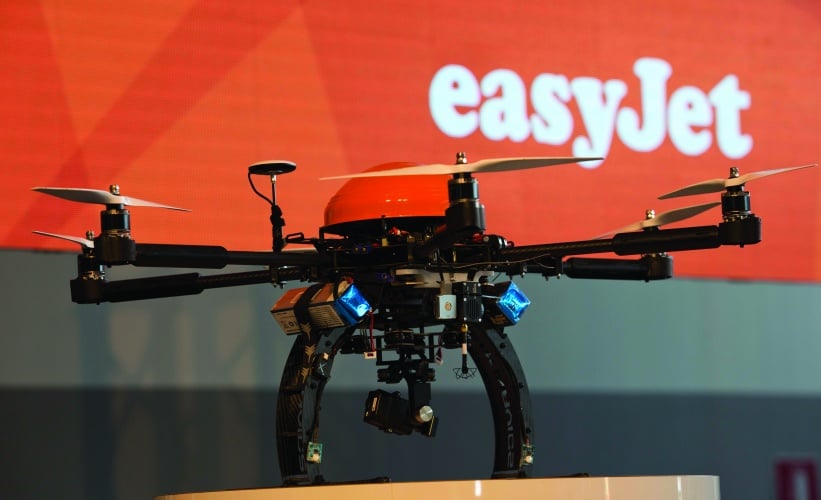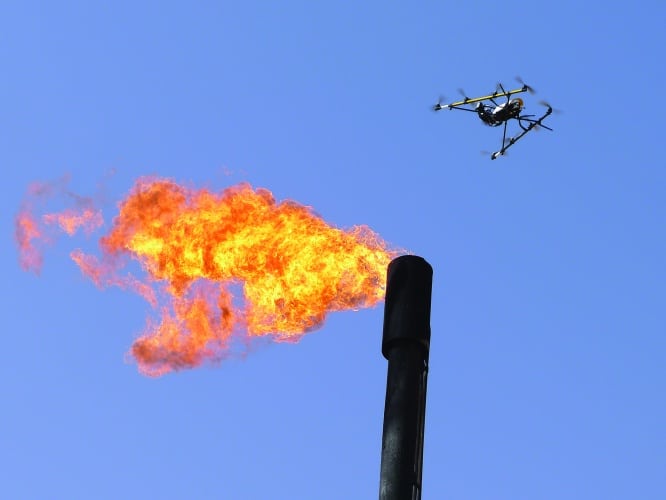Remotely operated aerial vehicles (ROAVs) – often referred to simply as ‘drones’ – have been in the news recently for all the wrong reasons. One week, a drone is spotted 50ft from a passenger jet landing at Heathrow; the next, some misguided teenager has armed one with a handgun. But while the emergence of ROAVs is undoubtedly raising issues that need to be addressed, there are also major benefits to be gained from this aerial revolution.
Buoyed initially by the media sector, commercial drone use has been on the rise since ROAVs became readily available. More recently, however, the commercial market has expanded to include more inspection and survey work, with energy, defence and transport all embracing the technology. Just a few months ago, EasyJet revealed details on its plans to use drones to inspect aircraft following lightning strikes. According to project manager Mark Bunting, the technology could speed up the inspection process.

“Today the lightning-strike inspections take several hours and it can take longer to identify the limits within the aircraft maintenance manuals,” he said. “The drone inspections will reduce this and by capturing accurate footage we can share it with the aircraft manufacturer and speed up the assessment process as well.”
”By performing an inspection in this way, we allow our operations centre to decide how to adjust the flying programme with the least amount of disruptionMark Bunting, EastJet
Since announcing its plans for drone technology in May 2014, EasyJet has conducted a number of trials. Initially it explored the feasibility of operating a flying craft in a working hangar, looking at key safety features such as unaided navigation, protected rotors, and system redundancies. In May 2015 it successfully completed its first trial with an automated drone, with no input via remote control.
“We have also put one EasyJet staff member through the RPQs – Remote Pilot Qualification – training programme,” said Bunting, “to ensure that we have a good understanding of what will be required of the people operating the drone, and allow us to ensure that they are introduced safely.”
The final system is expected to incorporate automated flight, supported by a pilot where required. Images will be fed to a qualified engineer, who, in consultation with the manufacturer, will be able to make decisions regarding the aircraft’s eligibility to return to service. By the end of 2016, EasyJet hopes to have drone inspection capability up and running in 10 locations across Europe, including Luton and Gatwick.
It’s projected that drones could help reduce inspection time from several hours to just half an hour. Aircraft in good working order could be back in service in a fraction of the time, avoiding costly delays. In the cut-throat world of budget airlines, minutes can equate to millions, and drone inspection could help EasyJet develop a competitive advantage over its rivals.
“By performing an inspection in this way, we allow our operations centre to decide how to adjust the flying programme with the least amount of disruption,” said Bunting.
While EasyJet is developing its own in-house solution and expertise for inspection, several companies offer tailored ROAV services across a range of industries. One such company is Cyberhawk. Formed in the UK in 2008, it operates globally in multiple sectors, with clients including BP, Maersk, Shell, Exxon Mobil, and Siemens. There are four levels of training within the company, with offshore oil and gas being the highest.
“We’ve really focused on having excellent engineers, excellent surveyors, excellent pilots, that can deliver results in these kinds of challenging environments,” explained Cyberhawk’s commercial director Philip Buchan, who is also a mechanical engineer.
Cyberhawk recently received approval from the Civil Aviation Authority (CAA) to fly drones in congested areas, including to within 10m of vehicles, structures and people not under its control. It said this permission will enable it to carry out a host of projects that have previously been prohibited under standard CAA permissions.

The company now also counts Network Rail among its clients, having succeeded in a recent bid for asset inspection and assessment work, as well as other projects such as surveying land for possible line extensions. Network Rail put out the tender after it became aware that several operators around the country were undertaking their own drone inspection work, in a piecemeal approach that it felt could lead to difficulties.
”We don’t just capture pictures, we don’t just capture data and deliver it to the client. We’re all about providing information to the client to actually make decisionsPhilip Buchan, Cyberhawk
“Network Rail is quite forward thinking, so it could see the benefits of ROAVs for inspection and surveying their network,” said Buchan. “But they became aware of lots of different operators doing lots of different things, to probably lots of different standards, close to their network and assets.”
The result was a contract that brought all the ROAV work under Cyberhawk’s roof. Buchan said the company’s end-to-end approach helps it stand apart from the competition, and it has developed a software platform called iHawk in an effort to add more value to the drone services it provides.
“We don’t just capture pictures, we don’t just capture data and deliver it to the client,” Buchan said. “We’re all about providing information to the client to actually make decisions. Part of that has been software development as well. So we now have a software platform that can deliver powerful asset information to our clients, rather than just raw data.”
Cyberhawk may be reaping the rewards from early adoption of drone technology, but the past few years have seen a host of new players enter the market. Like any technology in its infancy, teething problems are inevitable, and the bad press that follows can be damaging to the industry as a whole. It’s a problem that Adam Bailey is all too aware of. As well as being the founder of Kingfisher APS – a company that uses drones for close proximity surveys – he is also vice-chairman of ARPAS-UK (Association for Remotely Piloted Aircraft and Systems in the UK).
Formed in 2013, ARPAS originally consisted of just a dozen members who recognised the need for a professional body to represent commercial manufacturers and operators. Bailey said the 400-plus members it has today make up the bulk of the industry. A key component of this growth has been ARPAS’s non-profit status, along with relationships with industry bodies, regulators and pilot associations.
Away from ARPAS, Bailey’s work with Kingfisher includes an inspection project on Neath Port Talbot Hospital, as well as recent survey work near Grosvenor Place in Victoria. Getting permission to operate drones in cities can be difficult, and flying in central London provides unique challenges.
“It was 500m from Buckingham Palace, so obviously, there was a lot of issues with getting clearances because it’s highly restricted airspace,” explained Bailey. “But because we’ve got a long history of working in those environments, and because we’ve got safe systems of working in place, we can act to get it done.”
According to Bailey, one of the biggest challenges the industry faces moving forward is maintaining a positive public image, and preventing the regulator from overreacting to negative press.
“We need to engage the public and stakeholders on the positive aspects of drone use and the message of ‘Drone for Good’, rather than the press-led negative agenda, which circles around a few headlining stories that don’t actually reflect the landscape at large.”




Glasgow trial explores AR cues for autonomous road safety
They've ploughed into a few vulnerable road users in the past. Making that less likely will make it spectacularly easy to stop the traffic for...